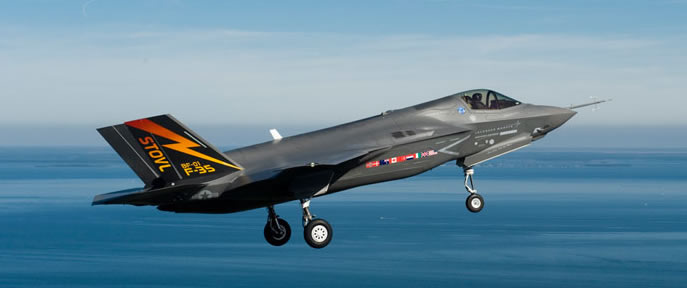The first Lockheed Martin F-35B Lightning II demonstrated its short takeoff, and vertical landing (STOVL) capability, during a series of test flights conducted over the test center at the Naval Air Station Patuxent River, Md. On March 18, 2010. These tests were a significant milestone leading in the verification of the aircraft STOVL capability, considered critical for future marine corps and international users. A first flight on that day verified the aircraft hovering capability with a follow-on mission completing vertical landing on the 95 foot pad. In the hovering test the F-35B confirmed predictions of the jet’s vertical thrust, stability and control in hovering flight.
Through this hovering test flight the pilot, Graham Tomlinson, initiated conversion to STOVL mode at 200 knots airspeed. He then slowed the aircraft to 60 knots and flew a decelerating approach to a zero airspeed hover at 150 feet above the runway. “This flightshowed that we have the thrust and the control to maneuver accurately both in free air and in the descent through ground effect” Tomlinson commented, adding that the low workload in the cockpit contrasted sharply with legacy short takeoff/vertical landing (STOVL) platforms. Doug Pearson, Lockheed Martin vice president of F-35 Test and Verification added that this first flight test is one of many such tests to be conducted through the further expansion of the aircraft’s operational flight envelope.


The hover flight that preceded the vertical landing marked the first free air hover and landing in the F-35B Lightning II aircraft. Upon reaching zero airspeed, the pilot executed test points to confirm the controllability of the aircraft in the hover. After completing all hover test points, the pilot executed a STOVL landing at 70 knots airspeed. Few hours later the BF-1 aircraft performed the first F-35 short takeoff, employing STOVL mode lifted off enabled the aircraft to take off at an airspeed of only 100 knots, using less than 1000 feet of runway.
The F-35B STOVL capabilities are critical to support operations from unprepared, forward operational airbases and amphibious ships, employed by Marine Corps aviation groups. Today, sofar the AV-8B and V-22 have STOVL performance.
(Photos by Andy Wolfe, Lockheed Martin)


















